Alaska Fish & Wildlife News
January 2016
Bears on the Move
Brown Bear Dispersal and Home Ranges
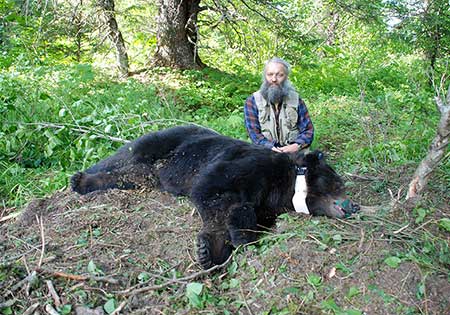
Something was up with Bear 425.
Bear researcher LaVern Beier had handled hundreds of brown bears, many from Admiralty Island and many from the Southeast Mainland. He and his colleagues caught Bear 425 in the Berners Bay area north of Juneau in June of 2007, and as Beier processed the roughly 9-year-old male and put on a GPS collar, he noted among other things, it seemed really dark for a Berners area bear.
The genetics data supported his suspicion that Bear 425 might not be from the Berners area. Instead, the genetic signature is strongly associated with bears from Admiralty Island. State bear biologist Anthony Crupi referred to microsatellite genotypes and polar-bear-like mitochondrial DNA, and said, “The DNA falls right in the middle of the Admiralty cluster and nowhere near the Berners population structure.”
Dispersal
Grizzly bears generally live near where they are born, especially females. Known as brown bears in coastal Alaska, these bears establish home ranges where they live out their lives. But some bears make exceptional forays into uncharted territory, usually returning and sometimes not. It’s possible that Bear 425 swam a dozen miles across Stephens Passage (maybe resting on intermediate islands) and moved north at least 80 miles.
How bears use their habitat, why and when they move and where they go, is of keen interest to bear researchers. Understanding what most bears usually do (and differences between males and females) is critical to managing bears and living around bears. But some bears do unusual things, and new technology like GPS collars and DNA analysis are providing surprising insights.
Dispersal is the movement of offspring away from their natal home range (their parent’s home range where they grow up) to their adult home range and breeding area. Dispersal minimizes inbreeding and reduces competition for resources and mates among related individuals. At the population level it leads to gene flow and genetic diversity and facilitates range expansion and the colonization of new areas.
Many mammals have a home range, and they learn where all the resources are. For a bear, that’s berry patches, salmon streams, dens, day beds, and potential mates. Since brown bear moms raise cubs, the best deal for a young adult (3 or 4 years old) would be to inherit the mother’s home range. That sometimes happens, but usually the mother chases off the young. Over the course of two or three years they establish a home range. For females, it tends to be adjacent or nearby; males tend to move farther, often much farther.
Crupi (referencing a textbook definition) described a home range as: “that area traversed by the individual in its normal activities of food gathering, mating and caring for young. Occasional sallies outside the area, perhaps exploratory in nature, should not be considered as in part of the home range.”
There’s an important difference between a home range and a territory. A territory is defended, a home range is not. “Bears may defend a food cache (like a carcass), or a fishing spot on a river, but it’s very localized,” Crupi said.
“Bears are solitary, non-territorial with a promiscuous breeding social structure. Wolves are antagonistic toward each other,” he said. “Both animals learn the resources in their home range, but wolves will defend their territory.”
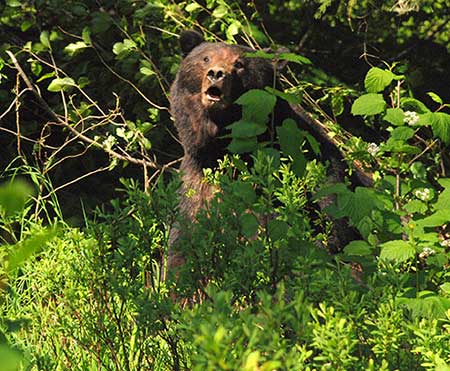
Crupi noted there are exceptions. There are transient wolves without established territories, and some bears are aggressive toward other bears without the usual provocations. But generally, bears are tolerant.
“Bears killing other bears is rare,” he said. “When we see bears kill other bears, it tends to be in the breeding season. We’ll see evidence of fighting in May and June, bite marks in the collars, or they’re torn off.”
Overlapping home ranges
Researchers studying grizzly bears in a large area of Southwestern Canada genetically sampled 711 bears. They found that on average, females dispersed 14 km from the center of their natal home range. Males dispersed on average about 42 km. They estimated the size of the male bears’ home range to be 579 square kilometers, and females to be 186 square kilometers.
An area of 579 square kilometers roughly translates to a square about 15 miles on a side. The females’ range is considerably smaller, about eight miles per side. The female’s home ranges tend to be adjacent to their mothers’ home range.
In the early 1980s, ADF&G began research on Admiralty Island brown bears. Researchers, including LaVern Beier, captured and radiocollared 68 bears on the northern portion of the island and in the ensuing years relocated the bears 3,192 times using telemetry. They estimated the density of bears in the area to be about one bear per square mile, one of the highest density brown bear populations in the world. They replicated the census in 1993 with similar results. Extrapolating the estimate to the entire island suggested a population of about 1,700 bears on Admiralty Island.
Biologists John Schoen and Kim Titus found that male bears’ home range averaged about 39 square miles (101 square km) and females’ range was 14 square miles (36 km squared). Given the number of bears and the size of the home range, the home ranges overlap. One bear per square mile - and a male’s home range is about 6 x 6 miles square.
“When there is a lot of food and a high density of brown bears, the bears are willing to tolerate each other. It’s food associated,” Titus said.
That’s seen seasonally at places like McNeil River, where salmon runs draw large numbers of bears.
“Admiralty home ranges are tiny compared to other places,” Crupi said. “Bears in systems without salmon have much larger home ranges.”
That’s true on the North Slope of the Brooks Range. State wildlife biologist Dick Shideler said he knows of males there with home ranges that exceed 4,000 square miles, and females whose home range were 1,200 square miles, almost the size of Admiralty Island.
Titus and Schoen wrote in 2001 that in 20 years of work they did not observe a single radio-collared bear dispersing from Admiralty Island.
Anthony Crupi, LaVern Beier and Rod Flynn have been studying brown bears in the Yakutat area of Southeast Alaska since 2009. They’ve captured and GPS collared 92 brown bears in the Yakutat Forelands area; while conducting a population study in 2013 they collected 850 hair samples using hair snares, and identified 152 individual bears.
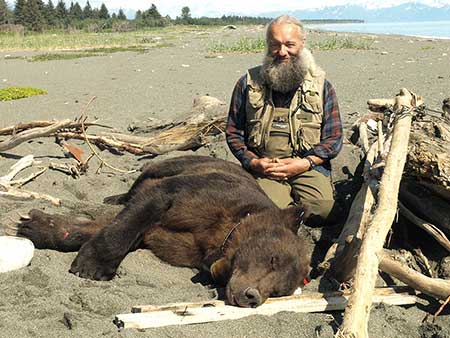
While the Yakutat Forelands area isn’t an island, it has significant constraints. The landscape is a strip of land hemmed in by glaciers and mountains to the north and east and the Pacific Ocean to the south and west. Yakutat Bay and the Malaspina Glacier to the north and Alsek Lake to the south define a chunk of good brown bear habitat roughly 10 to 20 miles wide and 70 miles long, about 1,200 square miles.
Crupi and his colleagues found that the 92 collared bears exhibited forelands-wide movement. The home ranges that young adult bears establish are essentially part of the forelands-wide shared use area.
He had sufficient home range data for 33 females and 35 males, of various age and reproductive status. Female annual home range of 193 km squared (120 sq miles) and males are three times larger, 598 km squared (370 sq miles).
Another 18 bears were collared and tracked across Yakutat Bay on the Malaspina Forelands to the north. On the Malaspina side, the average home range for a male bear is two-and-a-half times larger than for female bears - 462 square kilometers (178 sq. miles) for males and 184 square kilometers (71 sq. miles) for females.
In the spring, females with cubs move about a kilometer a day, while adult males are traveling about five kilometers a day. In late summer females with cubs are traveling more, about five km/day, and males about six km/day.
“Home ranges are smallest for everyone in the spring and larger in late summer when they’re looking for fish and strawberries,” Crupi said.
Forays
While dispersal makes sense intuitively, there is a lot that’s not understood, and mammals with different social structures behave differently. One line of thought suggests that low-ranking, subordinate individuals, usually juveniles, are forced to move out to sub-optimal habitats because they are driven out by more aggressive, dominant individuals. That makes sense, and certainly plays a part - but there are lots of exceptions, and aggressive animals aren’t always dominant. Food supply, predators and disease also influence dispersal, as well as the affect individual animals have on one another.
One thing that is observed in many species is the tendency of some individuals to make forays – short term exploratory movements outside the boundaries of a home range. It’s usually young adult males, but Alaska researchers found older males taking these “walkabouts.” One of the 18 Malaspina study bears made an exceptional foray – an 8-year-old male made a month-long 130-mile circumnavigation of the Malaspina Glacier before returning to the Malaspina Forelands.
Six of the 92 bears collared in the Yakutat Forelands made forays, and all came back. Bear 740 left the forelands in July of 2013 and moved up the Alsek River, almost to the confluence with the Tatshenshini River, near the U.S. - Canada border. He returned to the coast in late August, covering about 100 miles.
Bear 860 covered even more ground. Like most Yakutat Foreland bears he spent the summer of 2014 along the coastal salmon streams and the abundant berry patches of the low country (red dots on map). In autumn he moved south 30 miles down the coast and denned up in the foothills of the Fairweather Mountains for winter (about the very center of the map). In the spring, he went even further south and spent time around Lituya Bay, explored the foothills of the Fairweathers, returned to the coast and moved another 15 or 20 miles south before turning around and doing something Crupi had never seen before.
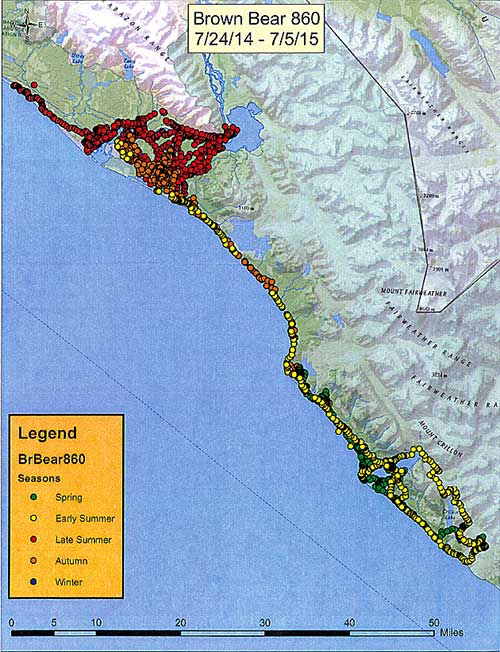
“He went back to his den in June,” Crupi said. “He went back to his den and checked it out before coming all the way back north, about 100 miles.”
Another bear, a 6-year-old male, swam across Yakutat Bay and made a 150-mile loop north around the southern foothills of the Malaspina Glacier before returning to 100 yards of where he was collared. He left the abundance of resources near Yakutat for the meager picking on the Malaspina side of the bay. Since this was in May and June, Crupi guesses he was looking for mating opportunities.
Beier noted that two decades ago, when VHF radiocollars represented the researcher’s most sophisticated tracking tool, that foray would have gone completely undetected. While the GPS collar logs and records the location periodically, a VHF collar requires the biologist to go look for the animal and physically find it.
“It would not have been on our radar to even look, considering the distance to swim across a bay plugged with icebergs, not to mention the Malaspina side is a hungry moonscape in comparison to the bountiful Yakutat Forelands…considering those physical challenges we would never have flown across the bay to the Malaspina Forelands to search for a Yakutat bear if he was missing. We only documented that epic swim because of GPS technology.”
Beier said that during the Admiralty Island work in the ‘80s and ‘90s he, Titus and Schoen discussed the possibility that Admiralty bears might leave, and they had heard “urban legends” of brown bears swimming across large bodies of water, but they never found evidence. “Now with GPS data combined with DNA we have examples of bears making previously undetected forays. DNA does a better job I believe of getting at dispersal for specific populations.”
Beier pointed out that in most cases he’s seen, it is not subadult bears establishing new home ranges that are making these forays, but adults. He recalled a dozen examples over 30 years of bear research of remarkable forays by adult bears – all males – many which involved swimming rivers, ocean passages, or crossing glaciers.
While some bears make these unexpected forays, other bears don’t make the movements you would expect. Beier wrote, “On Admiralty, Schoen and I discovered that there were brown bears that never moved down to salmon streams to eat salmon, even though they could look down on the streams. These were ‘Interior island’ bears, all old females. During the summer months when the salmon were running we would fly our telemetry flights at all hours of the night (as long as we could see) to debunk the nay critics and unbelievers. They would say, ‘…those bears ran down to the streams and fished while you were sleeping in town, that’s why you never located them on a salmon stream.’ It would have been nice to have had the GPS technology back then.”
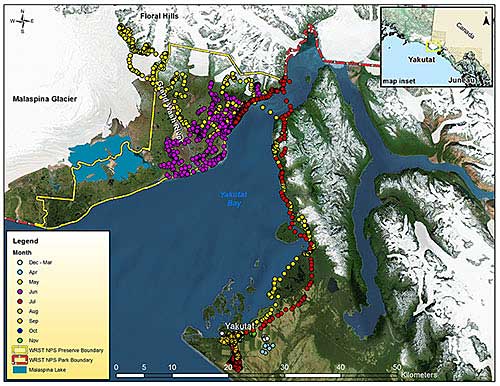
Kim Titus offered further evidence, based on another new technology, stable isotope analysis of blood and hair samples, which provides insights into diet. Titus said those females in the high peaks region of Admiralty did not have a "salmon signature" based on stable isotope analysis.
Beier cautioned about comparing bears from different areas. “Different populations of bears behave differently,” he said. “They’ve adapted to their surroundings and they’re not going to do the same things.”
For example, Berners and Yakutat area bears den and hibernate at much lower elevations than Admiralty Island bears. The average elevation for a Berners den is 201 meters above sea level (660 feet). Brown bears on Admiralty den in the alpine, more than 750 meters (2,500 feet) above sea level. Admiralty bears are frequently found in alpine habitat, Berners bears, almost never.
A total of 48 brown bears were captured between 2006 and 2009 in the Berners Bay research project (including Bear 425), and data collected on 30 bears was sufficient to examine home ranges and movement patters. Of those 30, five bears, all male, made movements well beyond the Berners Bay area. Two traveled about 50 miles north to the Katzehin River and returned in the fall. Bear 428 traveled at least 1,255 kilometers (780 miles) before returning in late December to den up. Bear 425 went south to the Eagle River, and Bear 421 went another 15 or 20 miles further south, to Tee Harbor.
While the forays are interesting, it’s remarkable how many bears did not leave their home ranges. In the Yakutat Forelands, 86 bears out of 92 did not leave their home ranges. In the Berners Bay area, 25 out of 30 Berners Bay bears did not take forays. And all the collared bears returned from their “walkabouts.” But some do not return.
“A bear might find a new area that will support it and stay,” Crupi said.
Bear 425 never returned to Admiralty Island, as far as we know. He made his new home (range) in the Berners Bay area.
Southeast Alaska was covered in ice a few thousand years ago. As the glaciers melted and the landscape became habitable, it was colonized by bears. The area that is now Glacier Bay National Park was under ice just a few centuries ago. Park Service biologist Tania Lewis looked at the genetics of brown bears in the park and found that bears colonized the area from source populations to the east and west. Yakutat Foreland bears moved in from the northwest; and bears from the Haines area and Lynn Canal moved in from the northeast.
And they stayed.
More on Berners Bay brown bears and Malaspina brown bears
Subscribe to be notified about new issues
Receive a monthly notice about new issues and articles.
